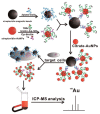Applications of Gold Nanoparticles in Non-Optical Biosensors
- PMID: 30486293
- PMCID: PMC6315477
- DOI: 10.3390/nano8120977
Applications of Gold Nanoparticles in Non-Optical Biosensors
Abstract
Due to their unique properties, such as good biocompatibility, excellent conductivity, effective catalysis, high density, and high surface-to-volume ratio, gold nanoparticles (AuNPs) are widely used in the field of bioassay. Mainly, AuNPs used in optical biosensors have been described in some reviews. In this review, we highlight recent advances in AuNP-based non-optical bioassays, including piezoelectric biosensor, electrochemical biosensor, and inductively coupled plasma mass spectrometry (ICP-MS) bio-detection. Some representative examples are presented to illustrate the effect of AuNPs in non-optical bioassay and the mechanisms of AuNPs in improving detection performances are described. Finally, the review summarizes the future prospects of AuNPs in non-optical biosensors.
Keywords: ICP-MS; biosensor; electrochemical; gold nanoparticles; piezoelectric.
Conflict of interest statement
The authors declare no conflict of interest. We declare that we do not have any commercial or associative interest that represents a conflict of interest in connection with the work submitted.
Figures










Similar articles
-
Applications of gold nanoparticles in optical biosensors.J Biomed Nanotechnol. 2014 Oct;10(10):2700-21. doi: 10.1166/jbn.2014.1987. J Biomed Nanotechnol. 2014. PMID: 25992415 Review.
-
Gold nanoparticles-based biosensors: pioneering solutions for bacterial and viral pathogen detection-a comprehensive review.World J Microbiol Biotechnol. 2024 Jul 16;40(9):269. doi: 10.1007/s11274-024-04072-1. World J Microbiol Biotechnol. 2024. PMID: 39009934 Review.
-
An ultrasensitive hydrogen peroxide biosensor based on electrocatalytic synergy of graphene-gold nanocomposite, CdTe-CdS core-shell quantum dots and gold nanoparticles.Anal Chim Acta. 2011 Sep 2;701(1):75-80. doi: 10.1016/j.aca.2011.06.015. Epub 2011 Jul 4. Anal Chim Acta. 2011. PMID: 21763811
-
Gold Nanoparticles Based Optical Biosensors for Cancer Biomarker Proteins: A Review of the Current Practices.Front Bioeng Biotechnol. 2022 Apr 26;10:877193. doi: 10.3389/fbioe.2022.877193. eCollection 2022. Front Bioeng Biotechnol. 2022. PMID: 35557858 Free PMC article. Review.
-
[Application of non-stationary phase separation hyphenated with inductively coupled plasma mass spectrometry in the analysis of trace metal-containing nanoparticles in the environment].Se Pu. 2021 Aug;39(8):855-869. doi: 10.3724/SP.J.1123.2020.12016. Se Pu. 2021. PMID: 34212586 Free PMC article. Chinese.
Cited by
-
In Situ Synthesis of Gold Nanoparticles from Chitin Nanogels and Their Drug Release Response to Stimulation.Polymers (Basel). 2024 Jan 31;16(3):390. doi: 10.3390/polym16030390. Polymers (Basel). 2024. PMID: 38337280 Free PMC article.
-
Detection of SARS-CoV-2 virus via dynamic light scattering using antibody-gold nanoparticle bioconjugates against viral spike protein.Talanta. 2022 Jun 1;243:123355. doi: 10.1016/j.talanta.2022.123355. Epub 2022 Mar 4. Talanta. 2022. PMID: 35272155 Free PMC article.
-
Fabrication of AuNPs/MWCNTS/Chitosan Nanocomposite for the Electrochemical Aptasensing of Cadmium in Water.Sensors (Basel). 2021 Dec 24;22(1):105. doi: 10.3390/s22010105. Sensors (Basel). 2021. PMID: 35009645 Free PMC article.
-
Novel Sensitive Electrochemical Immunosensor Development for the Selective Detection of HopQ H. pylori Bacteria Biomarker.Biosensors (Basel). 2023 May 8;13(5):527. doi: 10.3390/bios13050527. Biosensors (Basel). 2023. PMID: 37232889 Free PMC article.
-
Paper-Based DNA Biosensor for Rapid and Selective Detection of miR-21.Biosensors (Basel). 2024 Oct 8;14(10):485. doi: 10.3390/bios14100485. Biosensors (Basel). 2024. PMID: 39451697 Free PMC article.
References
-
- Gole A., Dash C., Ramakrishnan V., Sainkar S.R., Mandale A.B., Rao M., Sastry M. Pepsin−gold colloid conjugates: Preparation, characterization, and enzymatic activity. Langmuir. 2001;17:1674–1679. doi: 10.1021/la001164w. - DOI
Publication types
Grants and funding
- 201711535035/Research and Innovative Experiment Program for College Students in Hunan Province
- CNXY2017009/Open Fund of Guangdong Provincial Characteristic Key Discipline of Material Science
- 2016GCZX008/the Key Project of Department of Education of Guangdong Province
- 20172010018/the Project of Engineering Research Center of Foshan
LinkOut - more resources
Full Text Sources

